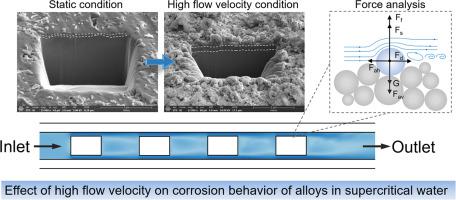The Journal of Supercritical Fluids ( IF 3.4 ) Pub Date : 2020-12-01 , DOI: 10.1016/j.supflu.2020.105126 Jianqiao Yang , Shuzhong Wang , Jiahuan Wang , Xingying Tang

|
In this study, the corrosion behavior of Ni-based alloy 625, 825, and Ni-Fe based alloy 800 was investigated in SCW containing salts and oxygen at 400 °C. The flow velocity of the corrosion medium near the sample surface was around 2 m/s. The surface and cross-section morphologies were observed, and the oxide phase was analyzed. After 100 h exposure, a bi-layer structure was formed on the alloy surface. The Ni and Fe rich outer layer was loose and porous, and the Cr rich inner layer was compact. Weight loss and oxide spallation were observed in the samples after exposure. The flow pattern near the test alloys was turbulent flow, but the outer oxide layer was immersed in the viscous sublayer. Once the Ni and Fe cations reached the alloy surface, some of them were carried away by the fast flowing fluid. Force analysis was done on an oxide particle from the outer oxide layer. The combining effect of the lifting force in the vertical direction and the shear force in the horizontal direction is the major reason for the porous structure of the outer layer and the oxide layer spallation.
中文翻译:

高速流动对超临界水氧化环境中镍基和镍铁基合金腐蚀行为的影响
在这项研究中,研究了Ni合金625、825和Ni-Fe合金800在含盐和氧气的SCW中在400°C下的腐蚀行为。样品表面附近腐蚀介质的流速约为2 m / s。观察表面和横截面的形态,并分析氧化物相。暴露100小时后,在合金表面形成了双层结构。富镍和铁的外层是疏松多孔的,富铬的内层是致密的。暴露后的样品中观察到重量损失和氧化物剥落。测试合金附近的流动模式为湍流,但外部氧化物层浸入粘性子层中。一旦镍和铁阳离子到达合金表面,其中的一些就会被快速流动的流体带走。对来自外部氧化物层的氧化物颗粒进行了力分析。垂直方向上的提升力和水平方向上的剪切力的综合作用是外层多孔结构和氧化物层剥落的主要原因。











































 京公网安备 11010802027423号
京公网安备 11010802027423号